
Bulgaria
For a full scale picture, please click on the picture shown !
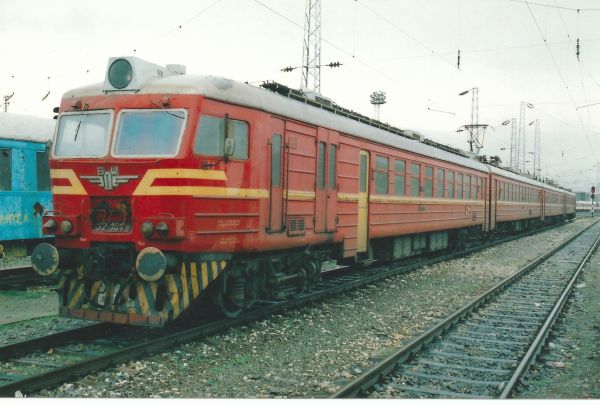
Bulgarian state railways Balgarski darzhavni zheleznitsi, BDŽ class 32 electric multiple unit. These trains were made at
RVR in Riga, Latvia. Latvia was then a part of Soviet Union and these are typical Soviet trains. This model is the same as
the Soviet Russian class ER25. It is otherwise the same model as ER9 which is used in many ex-USSR countries, except that
this export model got a rheostatic brake system.
Picture from Sofia in 2003 by Markku Salo.
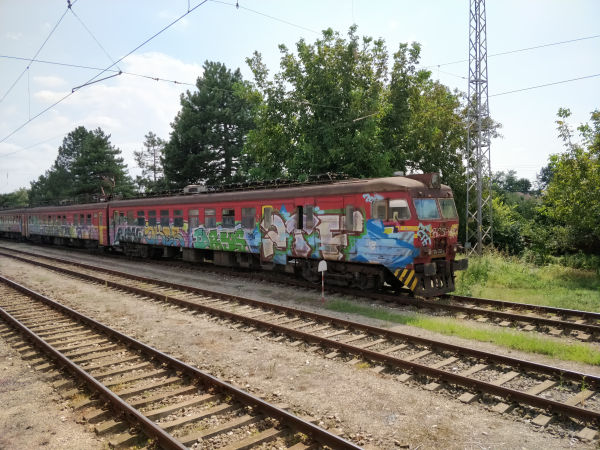
Bulgaria, just like many of the Balkan area countries are today suffering from a really terrible graffiti smearing problem of their
trains. This poor old train is a class 32 electric multiple unit.
Picture from Ivanovo 15.8.2019 by Markku Salo.
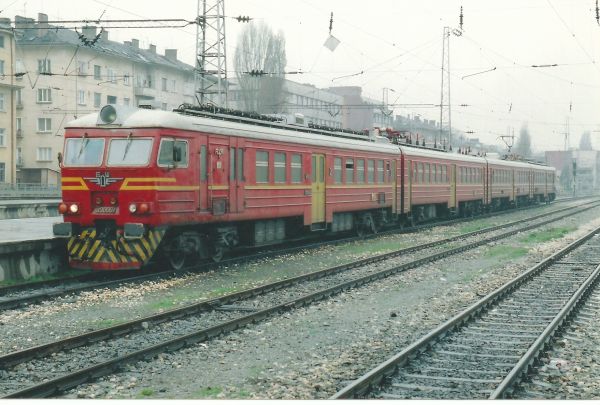
Bulgarian state railways BDŽ class 33 is also made by RVR in Riga and it is the same train that was in USSR called ER33.
This is a further development of the popular ER2/ER9 model of RVR (ER2 is for DC current, ER9 for 25 kV AC). RVR delievered
50 trainsets from 1980 onwards to the Yugoslav railways JŽ and they were called ER31. Then in 1990 Yugoslavia would have
wanted to buy nine more trainsets, but as the political tensions between president Tito's Yugoslavia and that time Soviet
Union got very tense, only three trains were delivered and the remaining six were sold to Bulgarian railways as their class 33.
This is one of those trains. These are fairly similar to the earlier class 32, but it is a simplified and cheaper variant.
Serbian railways also have almost similar trains as their class 412 (called in USSR ER 35) but the Serbian variant has
stronger motors. Those are now to be found in Macedonia. For pictures, see our Macedonian section of this archive.
Picture from Sofia in 2003 by Markku Salo.
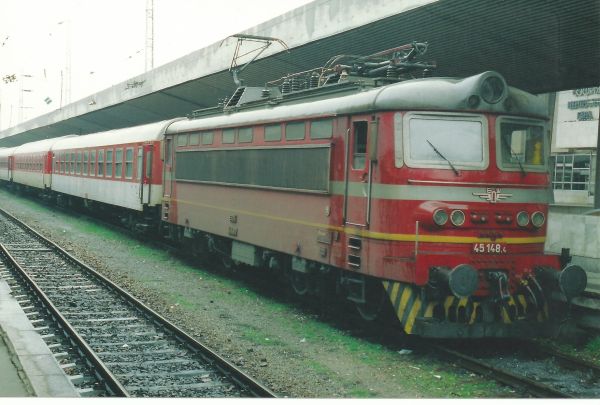
Bulgarian state railways class 45 locomotive leading an express passenger train into Sofia station. The class 45 was built by
Škoda Works in what then was Czechoslovakia. Classes 43, 44 and 45 are otherwise the same machine, but 45 is re-geared to be slower
and more powerful and it is intended for use in cargo trains. 43 is the basic model, 44 has in addition electrodynamic brakes
and is intended for fast passenger trains and 45 is the slower but stronger cargo model.
Picture from Sofia in 2003 by Markku Salo.
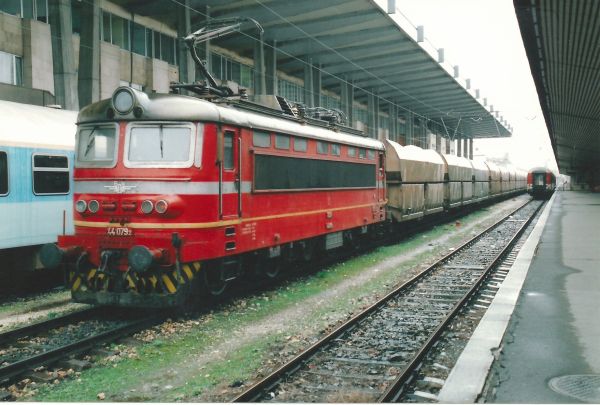
Bulgarian state railways class 44 locomotive leading a cargo train. In this picture and the picture above, the locomotives
are "the wrong way round": a passenger train locomotive is hauling a cargo train and the other way round :-)
Picture from Sofia in 2003 by Markku Salo.
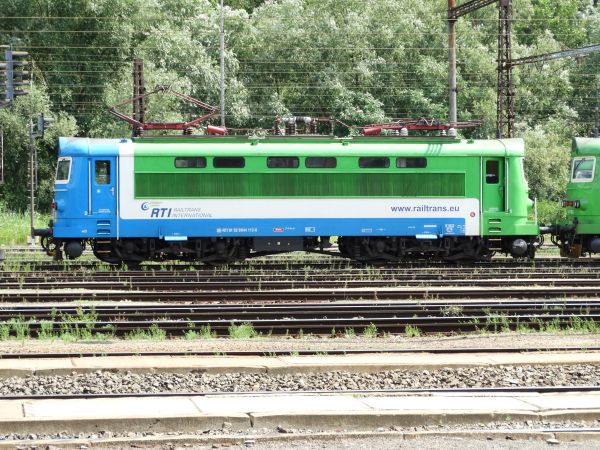
An old Bulgarian class 44 machine built by Škoda, here in front of a long cereals train at the Slovakian station of Kúty.
RTI Railtrans International is a company founded in 2011 and it is active in Czech Republic, Slovakia and Hungary. This machine
is registered in Bulgaria however and actually the UIC roster at its side shows only acceptance for use in Bulgaria, not in
Slovakia where this picture was taken. For more pictures of the same train, please see the section Slovakia -> private operators.
Picture from the station of Kúty in Slovakia 14.7.2018 by Ilkka Siissalo.
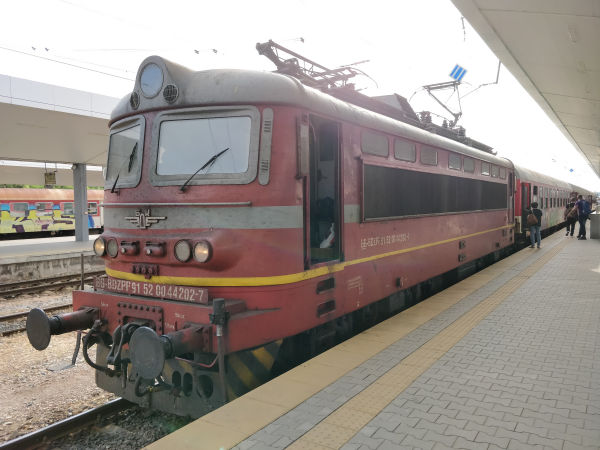
The class 44 locomotives built by Škoda in Czechoslovakia 1975-83 are still the by far most common locomotives in Bulgarian passenger trains.
It's basically identical with the class 45 except for its bogies. Class 44 is intended for passenger trains with speeds up to 130 km/h. The top
speed of class 45 is 110 km/h.
Picture of a class 44 locomotive from Sofia 15.8.2019 by Markku Salo.

Another class 44 Škoda built locomotive.
Picture from Gorna Oryachovitsa 15.8.2019 by Markku Salo.
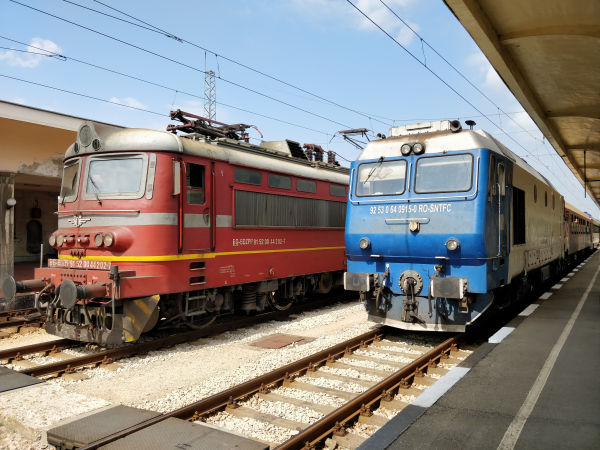
A Bulgarian class 44 Škoda and a Romanian class 64 diesel locomotive, originally built in Switzerland, meeting at the station of the border town Ruse.
Picture from Ruse 15.8.2019 by Markku Salo.
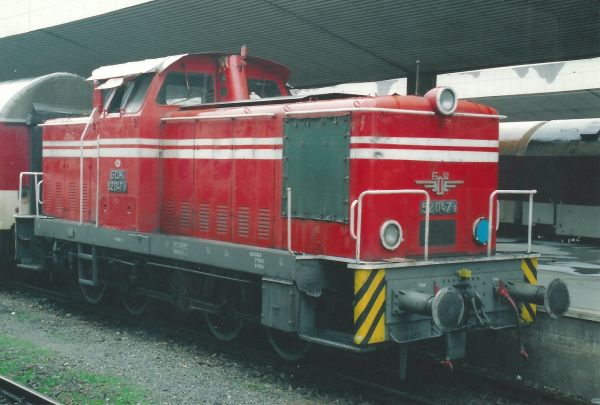
Bulgarian state railways class 52 is from former East Germany: This is the same machine which in former DDR's state railways
DR was called their Baureihe V60. It's a diesel shunter machine. They were built by LKM Babelsberg and LEW Hennigsdorf 1962 to 1982.
Its top speed is 30 km/h when in shunter mode and 60 km/h when in line service mode. Some of these machines are still in use in Germany.
Picture from Sofia in 2003 by Markku Salo.
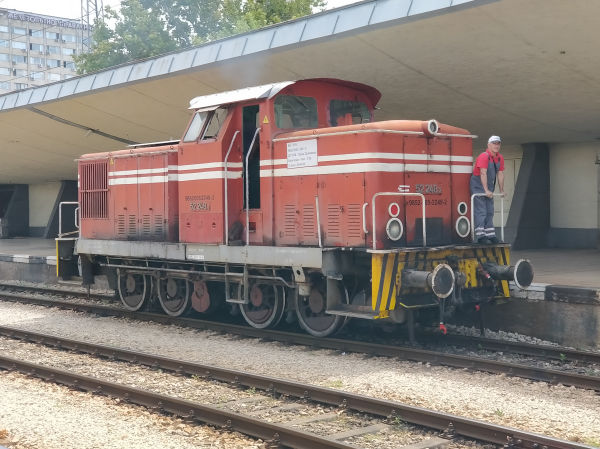
Another class 52 ( = Former DDR class V60) shunter diesel machine. This one is now owned by TSV, which is a state owned company for "transport,
construction and rehabilitation".
Picture from Gorna Oryachovitsa 15.8.2019 by Markku Salo.
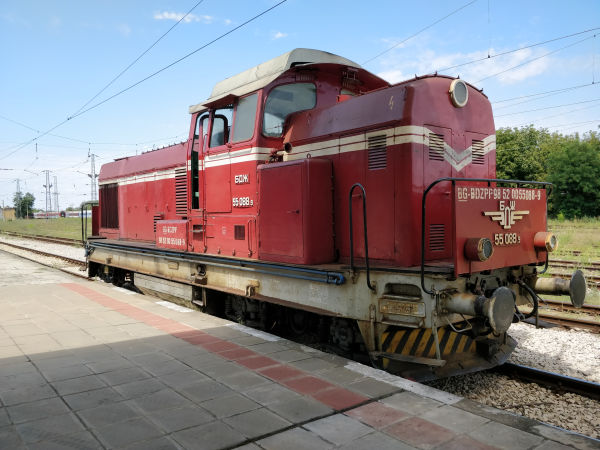
This is a class 55 diesel locomotive, built by the factory "23rd August works" (later Faur) in Bucharest. It is a fairly rare locomotive type which is mainly used in passenger services
on short-haul routes around Levski, but also used in heavy shunting. There are (probably) only 12 of these machines in Bulgaria.
Picture from Gorna Oryachovitsa 15.8.2019 by Markku Salo.
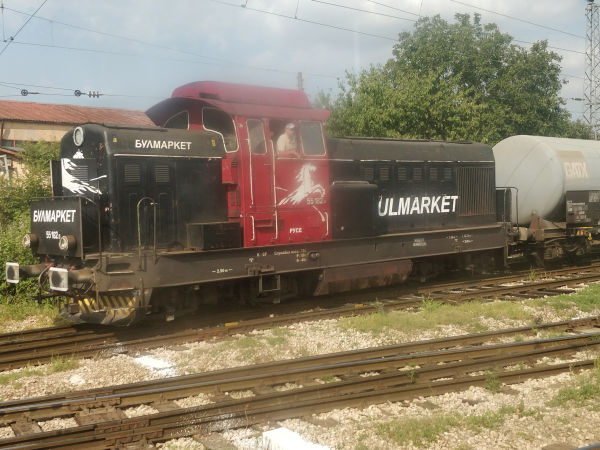
Another class 55 diesel locomotive, but this time one which is owned by the private company Bulmarket.
Picture from Ruse 15.8.2019 by Markku Salo.
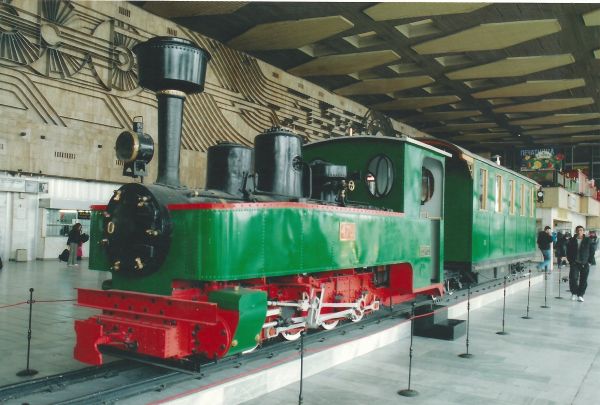
The Bulgarian state railways steam engine no. 479 stands inside Sofia's railway station as a monument together with one old coach.
They have a gauge width of 60 cm. The locomotive was built by Henschel and Son in Germany in 1918.
Picture from Sofia in 2003 by Markku Salo.
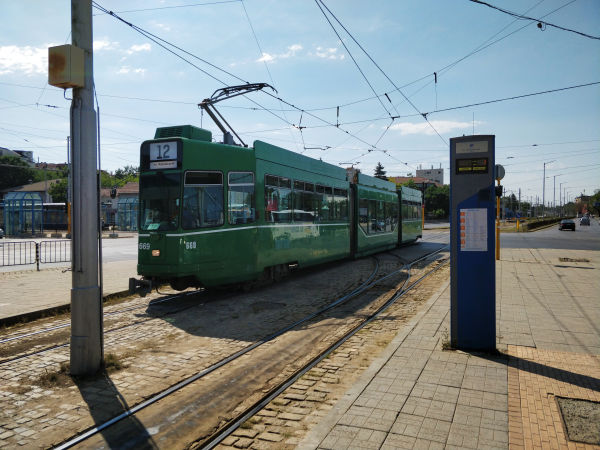
This tram is a former type Be 4/6 S of the city of Basel, Switzerland. These originally two-part trams were extended 1997-1999 in the
middle with a new low-floor section. Their nickname in Basel was "Guggummere". The last ones of the Guggummere trams were transported
to Sofia in October 2017 as they were no more needed in Basel because BVB got enough new low-floor, air conditioned trams of the type
Bombardier Flexity. Here we see the tram still in its Basel colours on line 12 in Sofia. These trams were built 1990-91.
Picture by the main railway station by the G.K. Banishora district of Sofia 14.8.2019 by Markku Salo.
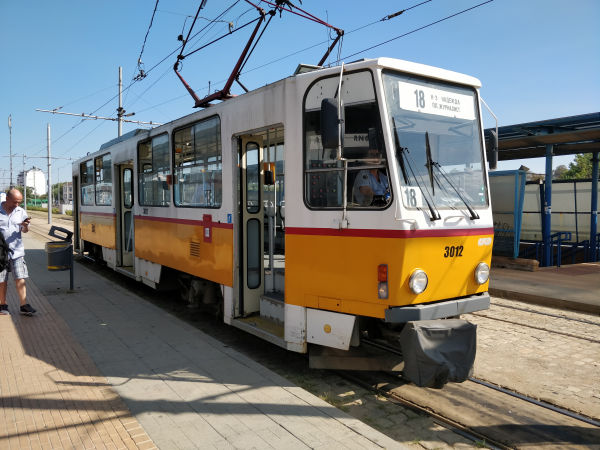
Eastern Europe was once absolutely full of these Tatra T6A2 trams made in what then was Czechoslovakia.
Picture by the main railway station by the G.K. Banishora district of Sofia 14.8.2019 by Markku Salo.
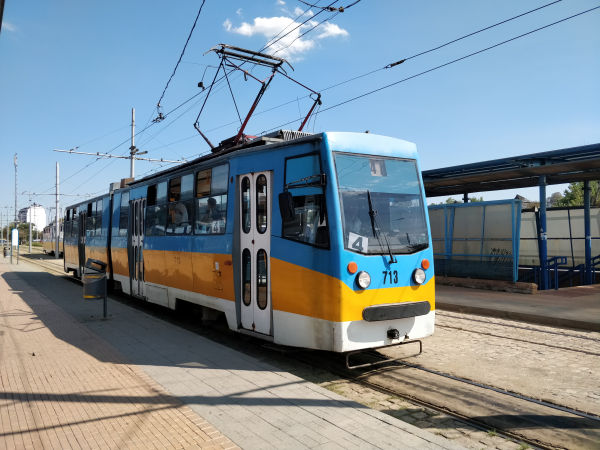
These trams were built in Bulgaria. The type is called T6M-700, built by the company Tramkar, modernised and rebuilt since 1998.
Picture by the main railway station by the G.K. Banishora district of Sofia 14.8.2019 by Markku Salo.
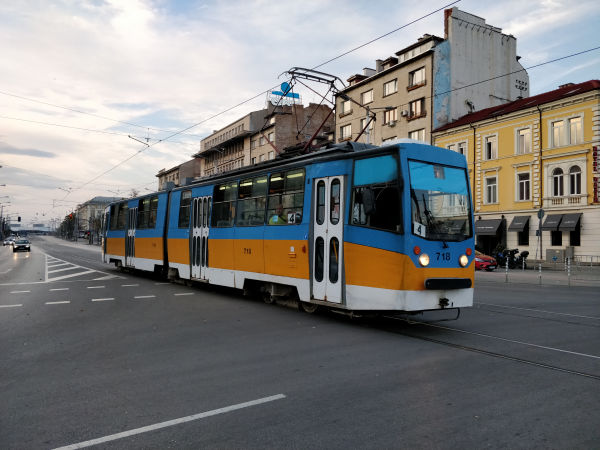
A similar T6M-700 tram, built by the company Tramkar, here on the Slivnitsa street near the metro station Lion's Bridge.
Picture by the Lions Bridge metro station of Sofia 14.8.2019 by Markku Salo.
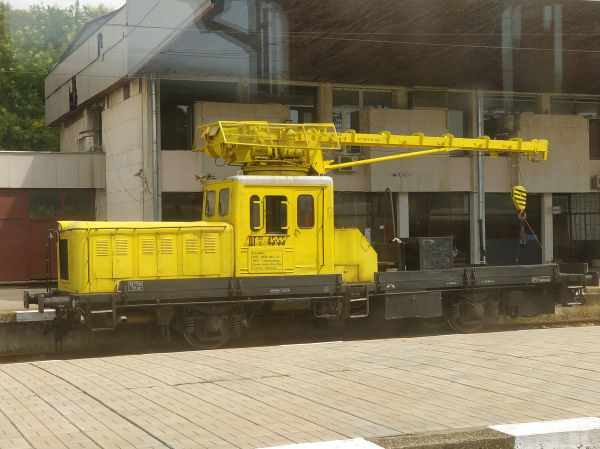
This is a class DG 45 rail crane, made in Russia, or what then was the Soviet Union. These rail trucks with sturdy cranes were once
commonplace throughout the former Soviet Union and also in many other communist block countries. Still today they often used for
example when replacing rails or sleepers. This crane is owned by NRIC. It is a company which takes care of the rail infrastructure
in Bulgaria.
Picture from the station of Levski 15.8.2019 by Markku Salo.

